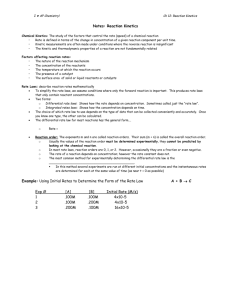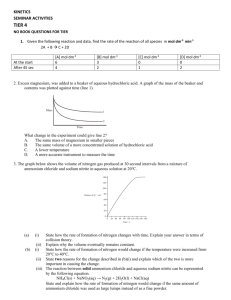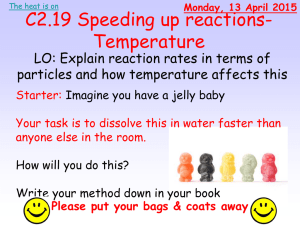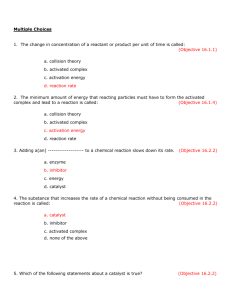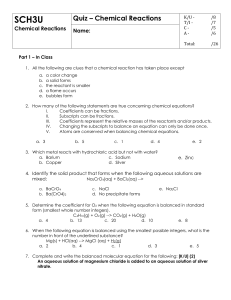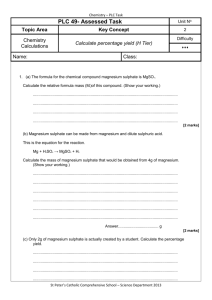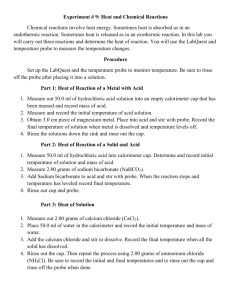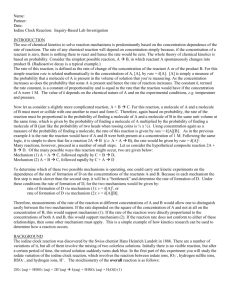Kinetics review
advertisement
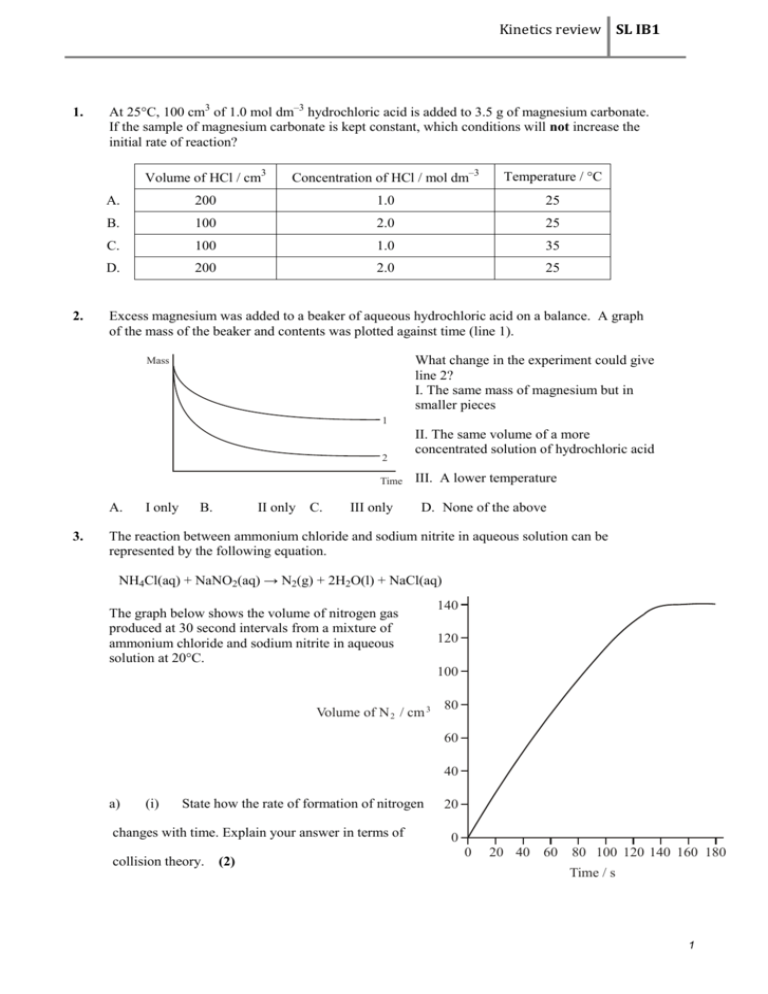
Kinetics review SL IB1 1. 2. At 25C, 100 cm3 of 1.0 mol dm–3 hydrochloric acid is added to 3.5 g of magnesium carbonate. If the sample of magnesium carbonate is kept constant, which conditions will not increase the initial rate of reaction? Volume of HCl / cm3 Concentration of HCl / mol dm–3 Temperature / C A. 200 1.0 25 B. 100 2.0 25 C. 100 1.0 35 D. 200 2.0 25 Excess magnesium was added to a beaker of aqueous hydrochloric acid on a balance. A graph of the mass of the beaker and contents was plotted against time (line 1). What change in the experiment could give line 2? I. The same mass of magnesium but in smaller pieces Mass 1 2 Time A. 3. I only B. II only C. III only II. The same volume of a more concentrated solution of hydrochloric acid III. A lower temperature D. None of the above The reaction between ammonium chloride and sodium nitrite in aqueous solution can be represented by the following equation. NH4Cl(aq) + NaNO2(aq) → N2(g) + 2H2O(l) + NaCl(aq) The graph below shows the volume of nitrogen gas produced at 30 second intervals from a mixture of ammonium chloride and sodium nitrite in aqueous solution at 20°C. 140 120 100 Volume of N 2 / cm 3 80 60 40 a) (i) State how the rate of formation of nitrogen changes with time. Explain your answer in terms of collision theory. (2) 20 0 0 20 40 60 80 100 120 140 160 180 Time / s 1 Kinetics review SL IB1 (ii) Explain why the volume eventually remains constant. ............................................................................................................................ ............................................................................................................................ (1) (b) (i) State how the rate of formation of nitrogen would change if the temperature were increased from 20°C to 40°C. ............................................................................................................................ ............................................................................................................................ (1) (ii) State two reasons for the change described in (b)(i) and explain which of the two is more important in causing the change. ............................................................................................................................ ............................................................................................................................ ............................................................................................................................ ............................................................................................................................ ............................................................................................................................ ............................................................................................................................ (3) (iii) The reaction between solid ammonium chloride and aqueous sodium nitrite can be represented by the following equation. NH4Cl(s) + NaNO2(aq) → N2(g) + 2H2O(l) + NaCl(aq) State and explain how the rate of formation of nitrogen would change if the same amount of ammonium chloride were used as large lumps instead of as a fine powder. ............................................................................................................................ ............................................................................................................................ ............................................................................................................................ ............................................................................................................................ (2) 2 Kinetics review SL IB1 4. (i) Draw a graph to show the distribution of energies in a sample of gas molecules. Label the axes and label your curve T1. Using the same axes, draw a second curve to represent the distribution of energies at a higher temperature. Label this curve T2. (3) (ii) State and explain, with reference to your graph, what happens to the rate of a reaction when the temperature is increased. ………………………………………………………………………………………….. ………………………………………………………………………………………….. ………………………………………………………………………………………….. ………………………………………………………………………………………….. ………………………………………………………………………………………….. (2) 5. (i) Magnesium is added to a solution of hydrochloric acid. Sketch a graph of acid concentration on the y-axis against time on the x-axis to illustrate the progress of the reaction. (1) (ii) Describe how the slope of the line changes with time. (1) (iii) Use the collision theory to state and explain the effect of decreasing concentration on the rate of the reaction. (2) 3 Kinetics review SL IB1 6. 7. Which of the following is (are) important in determining whether a reaction occurs? I. Energy of the molecules II. Orientation of the molecules A. I only B. II only C. Both I and II D. Neither I nor II In the Haber process for the synthesis of ammonia, what effects does the catalyst have? Rate of formation of NH3(g) Increases Increases Increases No change A. B. C. D. 8. Amount of NH3(g) formed Increases Decreases No change Increases Which of the quantities in the enthalpy level diagram below is (are) affected by the use of a catalyst? Enthalpy I II III Time 9. A. I only B. III only C. I and II only D. II and III only The rate of a reaction between two gases increases when the temperature is increased and a catalyst is added. Which statements are both correct for the effect of these changes on the reaction? Increasing the temperature Adding a catalyst A. Collision frequency increases Activation energy increases B. Activation energy increases Activation energy does not change C. Activation energy does not change Activation energy decreases D. Activation energy increases Collision frequency increases 4
